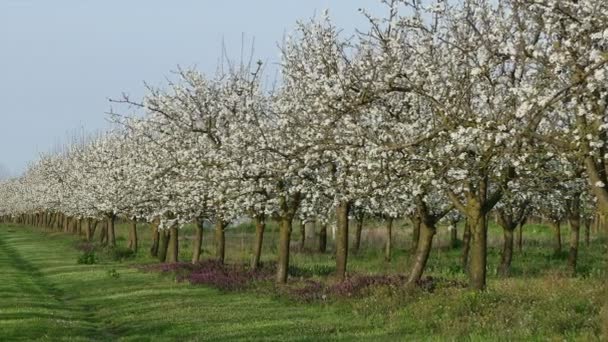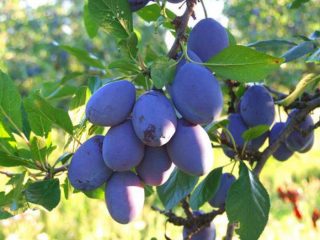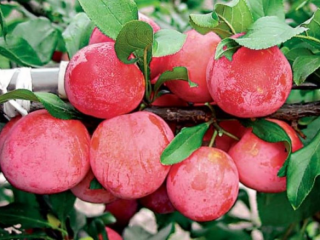Content
Early Zarechnaya plum is considered a popular crop among summer residents because it is easy to care for, grows for a long time, and blooms in the spring. Its fruits are tasty, and it does not require much effort to obtain a harvest. The Zarechnaya early plum variety will be used in home practice and farm selective agricultural technology.
History of variety selection
Early ripening plums of the Zarechnaya rannyaya variety were obtained not so long ago. In 1986, the variety was developed through selective crossing of three different plums. A year later, a derivation “formula” was obtained, which contained characteristics and notes from the observations of scientists. It was also already known how to care for it and when it is best to plant. Zarechnaya plum was registered in the State Register of G. in 1988.Kursakov as an early ripening variety. It was liked by many appraisers, and thanks to its characteristics it grows in latitudes with temperate climates. The homemade Zarechnaya early plum can withstand cold and heat, which makes it universal for many summer residents and breeders.
Most often it can be found in the CIS and Baltic countries. Sometimes plums can be found in areas of central Siberia where summers are warm and winters are not very harsh.
Description of early Zarechnaya plum
Early ripening varieties of plums are characterized by low growth, so their crown is spreading and dense. Average foliage indicates the impossibility of growing a dense harvest, but this does not prevent owners from enjoying ripe fruits.
Description of Zarechnaya plum can be discussed in more detail on the crown and foliage. The branches of this plum variety have a rounded shape and low shoots. The crown does not grow and develop quickly, but foliage appears earlier than shoots. This is not typical for early plum varieties, but Zarechnaya early is considered an exception in this regard.
The shoots of the early Zarechnaya plum are small and brown in color. The buds are a rich brown color, but small with a sharp crown. The pointed “bodies” are distinguished by the shape of droplets, which are pressed tightly against the shoots with their entire mass.
The Zarechnaya plum variety has large leaves that are slightly pointed, but still remain round. This compensates for their thin location, and due to their space they create shade. The flowers can be described as white shoots with a yellow tint, inside which the pistil is twice as large as the stamens. Inside, they are quite bright at the base - greenish with a slight orange tint.
The fruits of the Zarechnaya early plum variety are quite beautiful:
- These are beautiful purple sweets.
- Their shape is smooth, round, not flattened.
- The weight of one plum reaches 60 g.
- The wax coating is not too dense.
- The pulp of the Zarechnaya plum has a sweet taste with sourness, which disappears closer to the period of full ripening.
- The skin is not thick, but dense. It is difficult to bite through, but this preserves the taste and prevents the fruit from spoiling.
Thanks to these characteristics, the Zarechnaya Rannyaya plum variety tolerates transportation conditions very well. Transportable, almost indestructible in the refrigeration chamber, and is often the subject of export and import. The tasting score is 4.7 points, which is not bad for an early variety with small fruits and such a crown.
The homemade Zarechnaya early plum, the description of which has attracted the attention of many selectors, is considered a table variety. This makes it in demand among private owners and farming companies.
Characteristics of the variety
Characteristics of the Zarechnaya early plum variety differs from other species. Its data regarding resistance to cold and frost deserve special attention. Also attractive is its ability to survive extreme heat without requiring additional watering.
Drought resistance, frost resistance
The Zarechnaya early plum variety easily tolerates drought and frost. One-year and two-year-old seedlings should be covered with snow in the first years of life. In summer, only two waterings are enough, since the tree blooms and bears fruit quickly.
Pollinators of plum Zarechnaya early
The Zarechnaya early plum variety is considered self-sterile, so plums of the Renclod Tambovsky or Etude variety are always planted next to the seedlings. These pollinating plums allow you to get a rich harvest. The sketch will “transfer” its properties, rewarding the seedlings with future sweet fruits.One variety is enough. If you plant two pollinators at once, the Zarechnaya early plum will take on the properties of both varieties at once.
It is best to plant them on opposite sides of the Zarechnaya home. Then the fruits will be evenly distributed on the plum, and ripening will be as described.
It blooms in early spring and is ready to bear fruit within a few weeks. She divides them as quickly as she blooms. In just a week, plums of this variety grow, but ripen towards the end of spring. Then you can feel both a sour taste and a completely dessert taste.
Productivity and fruiting
The flowering period of the early Zarechnaya plum is short - only a few weeks after the snow melts. After the buds appear, the plum bears fruit - a week after the flowers bloom. The early-growing variety produces a harvest evenly distributed on the crown. The fruits ripen quickly, and the taste does not change, despite the harvest time.
Area of application of berries
The self-fertile Zarechnaya early plum is used for domestic and commercial purposes. Private owners plant it in their country garden. Farmers are resorting to planting large areas. Part of the plum goes to processing, where it is used to produce various secondary products, such as purees, juices and jams. For home use, it is suitable for making baked goods, compotes and jam. You should not use it for drying, as the skin is dense and the final product is too tough.
Resistance to diseases and pests
To prevent the plum from getting sick, it is advisable to plant it in the region in which it is zoned.The Zarechnaya early plum variety is not susceptible to severe and frequent diseases, but it is worth taking care of disease prevention, as sometimes it is affected by fungus and “colds”.
Advantages and disadvantages of the variety
It has many advantages, but there are also disadvantages. The height of the Zarechnaya early plum tree reaches more than 2 m, which is an undeniable advantage, because the harvest on it is large and dense due to medium-sized plums. The only disadvantage we can highlight is that the plum variety is early, and sometimes it is not suitable for seasonal sale.
Planting Zarechnaya plum
Before you stock up on materials and plant your garden with fruit trees, you should figure out what variety you need to plant. Much depends on the rootstock, water and soil fertility. The yellow Zarechnaya plum is also a relative of the early one, but it differs in the color and pulp of the fruit. Accordingly, these two varieties will look good together, since they require a maximum of one pollinator.
Early Zarechnaya plum does not tolerate hurricanes and strong winds, so you need to prepare a shelter in advance that would protect plums of this variety. Just for them, you can choose a small area right behind the house or along the fence. Clay and sand are their worst enemies, so they avoid such areas. The water level should reach 2 m, then the plum will take root.
There should be at least 3-4 m between plums of the same variety, preferably 5-6 m, so that they can spread their branches. The crown will create shade, so excessive watering in summer is not necessary.
Recommended timing
The optimal time for planting is considered to be early spring, as the name of the plum tree suggests.It is permissible to plant one-year-old seedlings, but only towards the end of spring, and in the fall – only two-year-old ones. Then the trees will survive both winter winds and slushy demi-season weather.
Choosing a suitable location
Early, like the Vengerka Zarechnaya plum, loves a cozy place, a nook that will protect from unnecessary winds and frosts. It should not be planted in the sun, because an excessive amount of UV rays will be unnecessary for the plum crown.
What crops can and cannot be planted nearby?
It is not recommended to plant fruit trees that are not pollinators. For Zarechnaya early plums there are not many of them, so it is permissible to plant one variety. There should not be an abundance of other fruit trees.
Selection and preparation of planting material
Before planting, a hole measuring 60 x 60 is dug. This is enough for the roots to adhere to the ground. A stake is installed at the bottom of the pit, which will serve as a support. The early Zarechnaya plum is not located close to the stake - it is 17-18 cm away from the center.
Landing algorithm
The process of planting the Zarechnaya early plum variety is as follows:
- After planting, the hole is filled with dirt.
- There is no need to prepare fertilizers, only after digging.
- A ditch is made around the plum tree, into which water is poured.
Immediately after filling the soil, you need to water the plums generously. It is advisable to do this in three or four passes so that the soil is initially saturated and the plum can “drink” for the next few weeks.
Aftercare for plums
To improve and maintain the quality of fruits, it is worth regulating the degree of fruiting and crown density:
- Unwanted layers are removed.
- Dry branches are pruned.
- The distance between the fruits is also manually adjusted.
- The branches are thinned out in productive years if it is necessary to reduce fruiting or make it even every year.
It is also important to install a support that will not come into contact with the tree trunk. They need to be installed under the branches so that they do not break under the weight of the harvest. There is no need to feed the first years of life. The Zarechnaya early plum variety does not need this, what is its advantage. But in the third year it is worth applying fertilizers:
- At the end of spring, urea is added and diluted in a bucket of water.
- Next month there will be more urea - already 1.5 times more.
- There is the same amount of urea in August as there was in May at the end of the season.
The tree no longer needs feeding. It remains to monitor the growth and uniform spreading of the crown.
Short trees withstand winters better when they grow wider rather than taller. Care will also be simplified, because not everyone will be able to reach the top.
Diseases and pests, methods of control and prevention
Diseases affect the President and Zarechnaya rannyaya plum varieties, which are similar to each other in this:
- Sometimes plums of this variety can develop bushiness and rust.
- Scab is also common.
- Clusterosporiasis and moniliosis are more common.
- Coccomycosis is the main problem when it appears.
Some diseases are very difficult to get rid of. Also, plums of the Zarechnaya early variety are threatened by pests: ringed silkworms love trunks and branches, as does the plum moth. And the hawthorn and fruit mite eat the leaves and all the fruits. Aphids attack shoots and early fruits.
Conclusion
Early Zarechnaya plum is a heat-loving tree that bestows fruits. To prevent Zarechnaya early plums from getting sick, you need to carry out preventive measures.The fruits must have the declared taste, and the condition of the tree must remain satisfactory.


















